News
Digital Manga Planning Tezuka Kickstarter Covering 6 Series
posted on by Lynzee Loveridge
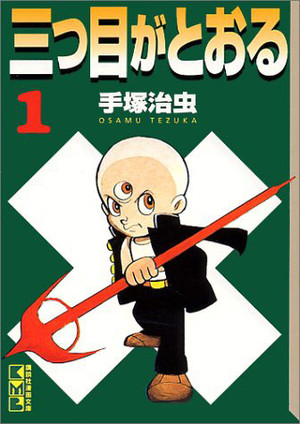 North American publisher Digital Manga announced on Friday that it is planning a Kickstarter campaign to fund six Osamu Tezuka manga titles for a total of 31 volumes.
North American publisher Digital Manga announced on Friday that it is planning a Kickstarter campaign to fund six Osamu Tezuka manga titles for a total of 31 volumes.
The main goal includes Tezuka's 13-volume The Three-eyed One and seven-volume Rainbow Parakeet manga. The first stretch goal includes Wonder Three and Alabaster followed by a second stretch goal to publish The Vampires and Birdman Anthology. Digital Manga expects to launch the campaign within two weeks.
The Three-Eyed One ran in Kodansha's Weekly Shōnen Magazine from 1974 to 1978. The official Osamu Tezuka website describes the story:
This is a science fiction story in which a boy with supernatural powers, Sharaku Hohsuke, probes into circumstances surrounding events in history. He is also a descendant of the "three-eyed tribe." A second-year student in junior high school, Sharaku Hohsuke never goes without a large bandage on his forehead. He is an innocent boy, like a little child. But once the bandage comes off, his third eye appears and he suddenly turns into a devil-like being, displaying horrifying psychic power. Sharaku Hohsuke is thrown into a series of mysteries related to our ancient heritage and treasures with his classmate Wato Chiyoko, who is a tomboy.
The manga inspired a 48-episode anime series in 1990 and the Viki website is streaming the series.
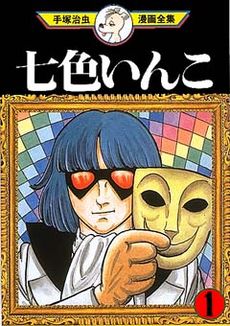 Rainbow Parakeet ran in Akita Shoten's Weekly Shonen Champion magazine from 1981 to 1983. The official Osamu Tezuka website describes the story:
Rainbow Parakeet ran in Akita Shoten's Weekly Shonen Champion magazine from 1981 to 1983. The official Osamu Tezuka website describes the story:
Rainbow Parakeet is a criminal action manga featuring a unique character: the parakeet is a genius actor whose specialty is mimicry, but he is also a thief. He accepts any role as a mimic, and performs it very well on the condition that the theater and the company overlook his stealing from the audience.A woman detective Senri Mariko follows him around in an attempt to arrest him, although she loves him. Then, Tamasaburo, a dog capable of performing as wonderfully as Rainbow Parakeet, joins the company.
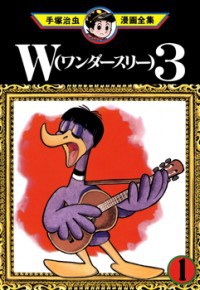 Wonder Three (The Amazing Three) ran in Shogakukan's Weekly Shonen Sunday magazine from 1965 to 1966. The series inspired the first original television anime created by Tezuka's Mushi Production studio and the first Japanese made-for-television animated program to use a specific animation illustrator for each specific character. The black-and-white series ran for 52 episodes from 1965-1966 and was later broadcast in the United States in 1967. The official Osamu Tezuka website describes the story:
Wonder Three (The Amazing Three) ran in Shogakukan's Weekly Shonen Sunday magazine from 1965 to 1966. The series inspired the first original television anime created by Tezuka's Mushi Production studio and the first Japanese made-for-television animated program to use a specific animation illustrator for each specific character. The black-and-white series ran for 52 episodes from 1965-1966 and was later broadcast in the United States in 1967. The official Osamu Tezuka website describes the story:
Amazing Three is an SF drama featuring three aliens who come to survey the earth and a human boy, Shinichi, and tells the story of their fight against various bad people.It is the year 196X, experiments with the hydrogen bomb continue and the world is at war. To resolve whether to save the barbarous earth or erase it with an antiproton bomb, the superior beings gathered in the Milky Way confederation deep in space decide to dispatch three investigators to earth.
So as not to appear suspicious to humans, Bokko, Pukko and Nokko, the three people in the Milky Way patrol known as the Amazing Three, are transformed into a rabbit, a duck and a horse and sneak into a village called Ogawa-mura somewhere in the countryside of Japan.
There they get to know a wild but simple-hearted boy called Shinichi Hoshi and start to run with him. Meanwhile, Shinichi's older brother, Koichi, is involved in a fight for justice as a member of the secret intelligence agency "Phoenix" against a global plot, a position he has concealed even from his own family.
Shinichi and W3 get sucked into this plot. Through their exchanges with Shinichi and Koichi, the three members of W3, who initially thought the earth was just a barbarous planet, find their feelings being gradually transformed.
AnimeSols is currently running a crowdfunding campaign for the Wonder Three anime series. If the site raises US$2,700 it will stream the first 13 episodes of the series.
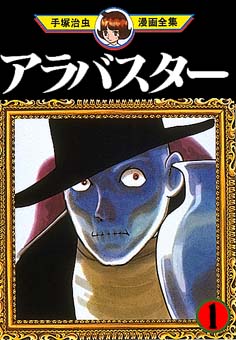 Alabaster ran in Akita Shoten's Weekly Shonen Champion from 1970 to 1971. The official Osamu Tezuka website describes the story:
Alabaster ran in Akita Shoten's Weekly Shonen Champion from 1970 to 1971. The official Osamu Tezuka website describes the story:
Alabaster is a criminal science fiction of suspense depicting the dark side of the human psyche that envies beautiful things.James Block is a young black man with sinister intentions. When he is in prison, a strange old man tells him about the "F" laser beam that makes humans and any other living things invisible. After he has been released from prison, James receives the F laser beam. But because the beam is imperfect, he becomes semitransparent with an ugly figure. From that time on, he calls himself "Alabaster" and hates anything beautiful.
Using the F laser beam, he begins to eliminate hypocrites and those who boast of their beauty. When living things are exposed to the F laser beam long enough to become transparent, they die. Meanwhile, Dr. F, who told Alabaster the secret of the F laser beam, had previously used his daughter as a guinea pig to investigate its effects. The daughter, who was pregnant at the time, gave birth to a girl. The girl, who was named Ami, is completely invisible. Alabaster approaches Ami and begins to use her for his dark purposes.
 The first part of The Vampires ran in Shogakukan's Weekly Shonen Sunday magazine from 1966 to 1967 followed by the second part in Shueisha's now defunct Shōnen Book magazine from 1968 to 1969. The official Osamu Tezuka website describes the Macbeth-inspired story:
The first part of The Vampires ran in Shogakukan's Weekly Shonen Sunday magazine from 1966 to 1967 followed by the second part in Shueisha's now defunct Shōnen Book magazine from 1968 to 1969. The official Osamu Tezuka website describes the Macbeth-inspired story:
In this unconventional work, a boy named Toppei who can transform himself into a wolf is the main character.The story begins when one day Toppei visits Mushi Productions, an animation production company, and persuades President Tezuka Osamu to hire him. Toppei, who actually belongs to a vampire tribe whose members transform themselves into wolves, has come to Tokyo to look for his missing father. The villain of the story, named Rock, discovers Toppei's secret, and then tries to plot against Toppei.
In the meantime, Toppei's tribe, which has long been oppressed by human beings, secretly plans a revolution against them. Toppei and Tezuka Osamu try to stop the revolution; Rock tries to use it to the advantage of his own wicked designs; and then the police get involved. Everyone's intentions got entangled, and Toppei is in danger of being cornered.
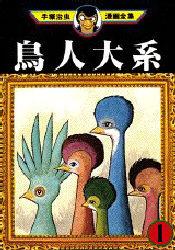 Tezuka's Birdman Anthology sci-fi series ran in Hayakawa Publishing's SF Magazine from 1971 to 1975. The official Osamu Tezuka website describes the story:
Tezuka's Birdman Anthology sci-fi series ran in Hayakawa Publishing's SF Magazine from 1971 to 1975. The official Osamu Tezuka website describes the story:
Birdman Anthology is a science fiction manga depicting an imaginary future society in which evolved birds control humans. One day, the birds on the Earth suddenly gain intelligence and attack humans so that they may rule the Earth.It is the plot of advanced bird-like aliens of a faraway planet. The birds deal with humans as livestock. They succeed the human civilization and build a more advanced world with countries, laws, currency systems and class. But all this means that the birds are following the same path that humans have. Then confrontation between the meat eating birds and the insect-and-grain-eaters. Their societies begin an endless war against each other.
In the meantime, on another planet, aliens start discussing which creature should replace the birds, the current ruler of the Earth. What will their conclusion be?
Digital Manga successfully funded a print edition of Tezuka's Captain Ken manga in June. Digital Manga also used Kickstarter to raise funds to reprint Tezuka's Barbara and Swallowing the Earth manga. The English release of Barbara was nominated for an Eisner last year.